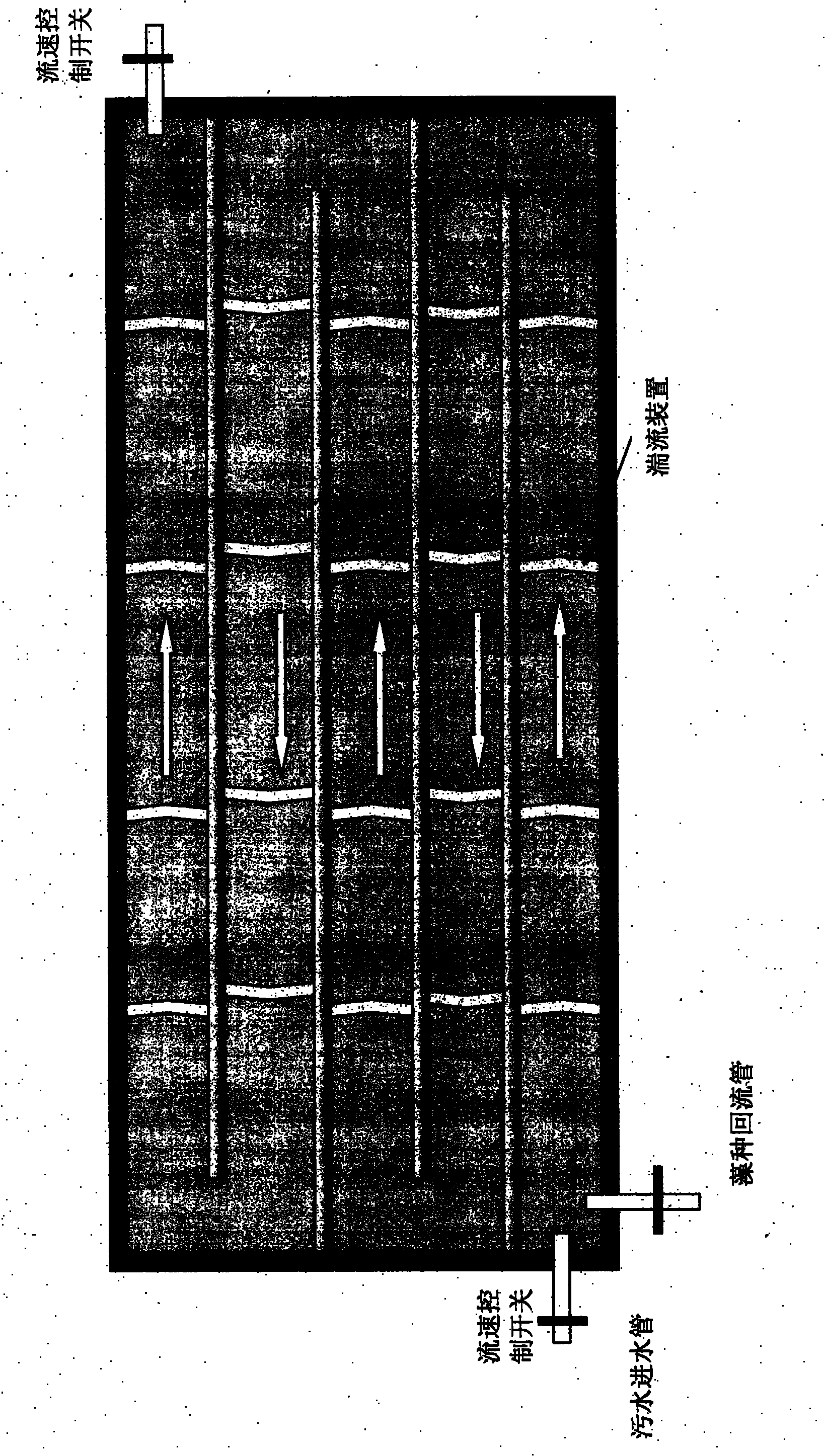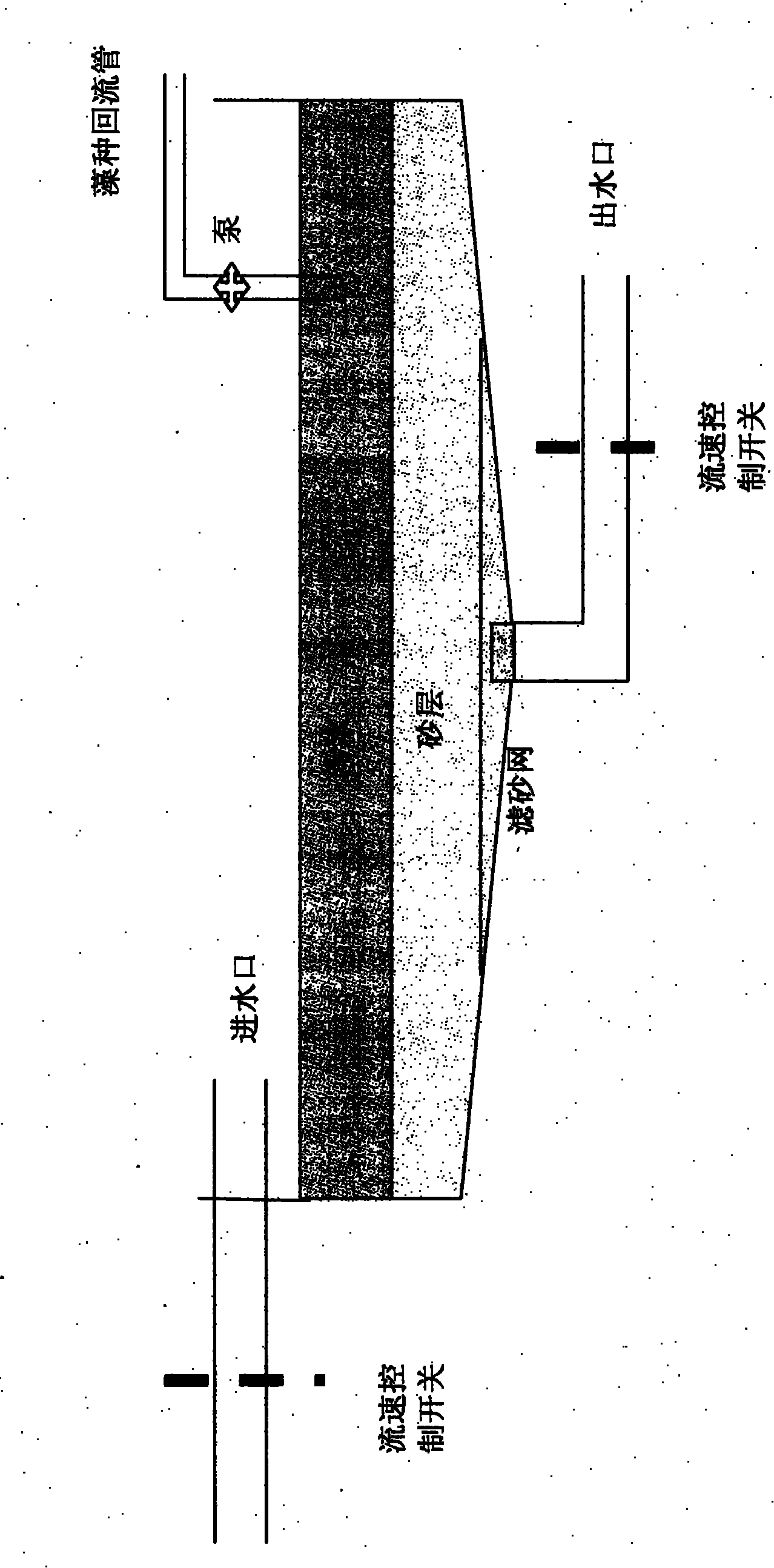Method for treating eutrophicated water body by using microalgae
A technology of eutrophication and microalgae, applied in microorganism-based methods, chemical instruments and methods, biochemical equipment and methods, etc., can solve the problems of large investment in processing technology, complex process and high cost
- Summary
- Abstract
- Description
- Claims
- Application Information
AI Technical Summary
Problems solved by technology
Method used
Image
Examples
Embodiment 1
[0067] Sodium bicarbonate 6.8-26.8g / L Sodium chloride 0.01-0.2g / L
[0068] Magnesium sulfate 0.05-0.3g / L Potassium sulfate 0.5-2.0g / L
[0069] Dipotassium hydrogen phosphate 0.1-2.0g / L Calcium chloride 0.01-0.09g / L
[0070] Sodium nitrate 0.5-4.5g / L Gibberellin 0.05-0.4mg / L
[0071] Trace elements 0.5-2ml / L
[0072] Wherein the trace element preparation method is:
[0073] Boric acid 1-5mg Ferric chloride 150-800mg
[0074] Zinc sulfate 0.04-0.3mg Sodium molybdate 5-40mg
[0075] Manganese sulfate 0.35-2.5mg Cobalt chloride 3.5-10mg
[0076] Copper sulfate 0.02-0.09mg Add distilled water to 1L
[0077] The culture conditions are: temperature 28-32°C, light 4000-25000 lux, pH: 6.5-8, growth cycle 5-8 days.
[0078] A better medium formula is:
[0079] Sodium bicarbonate 10.8-20.8g / L Sodium chloride 0.01-0.2g / L
[0080] Magnesium sulfate 0.12-0.25g / L Potassium sulfate 0.5-1.6g / L
[0081] Dipotassium hydrogen phosphate 0.3-1.2g / L Calcium chloride 0.03-0.06g / L
[0082] ...
Embodiment 2
[0113] Sodium nitrate 0.1-2g / L Dipotassium hydrogen phosphate trihydrate 0.01-0.08g / L
[0114] Magnesium sulfate heptahydrate 0.01-0.15g / L Calcium chloride dihydrate 0.01-0.1g / L
[0115] Ferric citrate 0.001-0.012g / L Sodium bicarbonate 0.01-0.05g / L
[0116] Disodium EDTA 0.0005-0.002g / L Tridecyl Alcohol 0.1-1.0mg / L
[0117] Trace elements 0.5-2ml
[0118] Among them, the trace element configuration method:
[0119] Boric acid 1.43-5.72g / L Manganese chloride monohydrate 0.9-3.6g / L
[0120] Copper sulfate pentahydrate 0.04-0.16g / L Zinc sulfate heptahydrate 0.11-0.45g / L
[0121] Sodium molybdate dihydrate 0.2-0.8g / L Cobalt nitrate hexahydrate 0.025-0.09g / L
[0122] Add water to make up to 1L.
[0123] The culture conditions are: temperature 28-33°C, light 4000-25000 lux, pH: 6.5-8.5, growth cycle 5-8 days.
[0124] A better medium formula is:
[0125] Sodium nitrate 0.3-0.9g / L Dipotassium hydrogen phosphate trihydrate 0.02-0.06g / L
[0126] Magnesium sulfate heptahydrate ...
Embodiment 3
[0159] Potassium nitrate 0.2-0.5g / L Sodium dihydrogen phosphate dihydrate 0.005-0.25g / L
[0160] Calcium chloride 0.01-0.05g / L Potassium chloride 0.05-0.3g / L
[0161] Magnesium Sulfate 0.02-0.15g / L Auxin 0.1-0.9mg / L
[0162] Cytokinin 0.05-0.2mg / L Iron EDTA 0.01g / L
[0163] Sodium acetate 0.05-0.3g / L Trace elements 0.5-2.0ml / L
[0164] Among them, the trace element configuration method:
[0165] Manganese chloride tetrahydrate 0.1-0.4g / L Cobalt chloride hexahydrate 0.05-0.2g / L
[0166] Copper sulfate pentahydrate 0.01-0.04g / L Zinc sulfate heptahydrate 0.02-0.08g / L
[0167] Sodium molybdate dihydrate 0.005-0.025g / L
[0168] Add water to make up to 1L.
[0169] The culture conditions are: temperature 28-33°C, light 4000-25000 lux, pH: 6.5-9, growth cycle 5-8 days.
[0170] A better medium formula is:
[0171] Potassium nitrate 0.25-0.4g / L Sodium dihydrogen phosphate dihydrate 0.008-0.15g / L
[0172] Calcium chloride 0.02-0.03g / L Potassium chloride 0.05-0.2g / L
[0173] M...
PUM
| Property | Measurement | Unit |
|---|---|---|
| Thickness | aaaaa | aaaaa |
| Diameter | aaaaa | aaaaa |
| Thickness | aaaaa | aaaaa |
Abstract
Description
Claims
Application Information
 Login to View More
Login to View More - R&D
- Intellectual Property
- Life Sciences
- Materials
- Tech Scout
- Unparalleled Data Quality
- Higher Quality Content
- 60% Fewer Hallucinations
Browse by: Latest US Patents, China's latest patents, Technical Efficacy Thesaurus, Application Domain, Technology Topic, Popular Technical Reports.
© 2025 PatSnap. All rights reserved.Legal|Privacy policy|Modern Slavery Act Transparency Statement|Sitemap|About US| Contact US: help@patsnap.com


